Santa Cruz Island
This is the second largest island and Santa Cruz has, by far, the largest human population. This morning found us anchored in Academy Bay, named after the California Academy of Science who visited Galápagos twice during the last century. Theirs were some of the most important early scientific expeditions, and involved original studies of many specimens of the flora and fauna from the islands. The Cal Academy in particular collected and researched the giant tortoises.
Puerto Ayora is also the home of the headquarters of Galápagos National Park Service and the Charles Research Station; partners in conservation. We went first to visit the captive rearing center of giant tortoises where we saw hundreds of tortoises of different sizes and ages. They are destined to be returned to the islands of their origin, to restore their populations which are, in some cases, dangerously low and close to extinction in the natural habitat. There are two reasons for the low numbers of giant tortoises: exploitation for food by the early sailors, and competition for food and shelter with alien mammals that were brought to the islands a couple of centuries ago.
In the afternoon, following a satisfying lunch on a farm in the highlands, we searched for these ancient reptiles in the wild. We were thrilled to find over thirty of them, lumbering through lush vegetation, soaking in the muddy pool of “El Chato” or resting. Here in the highlands, even during the dry season the moisture from garua (mist) provides food, shelter and water for the tortoises. Epiphytes and mosses cover the trees and shrubs and trap the garua at this time of the year. It was interesting to visit the lush highlands and it has been another successful day in the Enchanted Islands.
This is the second largest island and Santa Cruz has, by far, the largest human population. This morning found us anchored in Academy Bay, named after the California Academy of Science who visited Galápagos twice during the last century. Theirs were some of the most important early scientific expeditions, and involved original studies of many specimens of the flora and fauna from the islands. The Cal Academy in particular collected and researched the giant tortoises.
Puerto Ayora is also the home of the headquarters of Galápagos National Park Service and the Charles Research Station; partners in conservation. We went first to visit the captive rearing center of giant tortoises where we saw hundreds of tortoises of different sizes and ages. They are destined to be returned to the islands of their origin, to restore their populations which are, in some cases, dangerously low and close to extinction in the natural habitat. There are two reasons for the low numbers of giant tortoises: exploitation for food by the early sailors, and competition for food and shelter with alien mammals that were brought to the islands a couple of centuries ago.
In the afternoon, following a satisfying lunch on a farm in the highlands, we searched for these ancient reptiles in the wild. We were thrilled to find over thirty of them, lumbering through lush vegetation, soaking in the muddy pool of “El Chato” or resting. Here in the highlands, even during the dry season the moisture from garua (mist) provides food, shelter and water for the tortoises. Epiphytes and mosses cover the trees and shrubs and trap the garua at this time of the year. It was interesting to visit the lush highlands and it has been another successful day in the Enchanted Islands.




